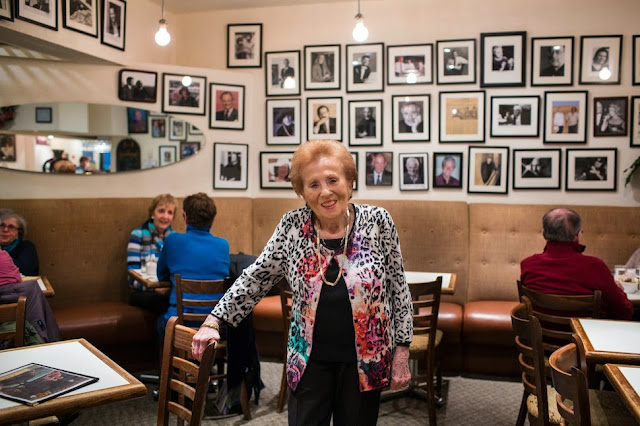Toronto’s Culinary Hot Spots 2016
Toronto’s Culinary Hot Spots 2016
BY BRYAN LAVERY
What is more exciting than planning a
culinary getaway to Toronto? Here are a few recommendations
and tips for navigating the vibrant and ever-changing restaurant scene and some
of Toronto’s hottest culinary tickets.
Park
your vehicle. There is an efficient transit system that makes it easy to get around
the city. More than that, Toronto is a walkable city of many communities with great restaurants, markets and culinary retailers.
Located on Front Street and operating since
1803, the St. Lawrence Market is heralded as the world's best food market by National Geographic. The other must-see
is Kensington Market, another noted gastronomic attraction, and colourful
vestige of the area’s storied history. The market is an expansive
multi-cultural culinary scene sprawling across numerous blocks to the west of
downtown’s vibrant Chinatown. Both markets remain a fundamental part of
Toronto’s epicurean culture, even for the most jaded of visitors.
The
revitalization of former industrial neighbourhoods like the Junction with its
proximity to High Park has meant a proliferation of upscale
restaurants, stylish cafes and indie bars opening along Dundas Street West. The Junction neighbourhood was ostensibly dry until 2001, and the elimination of prohibition has had
an irrefutable effect by attracting a new hip demographic. The Indie Ale House brewpub in the Junction is perfect for craft beer aficionados,
who like beer flights or quality upscale food offerings, or maybe just want to
pick up a growler to go. Praiseworthy spots in the ‘hood are Cool Hand of a
Girl, Nodo, and Bricco Wine Bar. Other standouts are Honest Weight, a New
England-inspired fishmonger/seafood spot, and a gourmet take-out sandwich shop,
Cut the Cheese. The Hole In the Wall is cozy venue for live music, craft beer
and cocktails. Don’t forget the Junction Farmers’ Market on Saturdays.
Chef
Rob Gentile and his partner’s third and most sophisticated restaurant is the
style-driven 100-seat Buca Yorkville, on the main floor of Yorkville’s Four
Seasons condo tower. A personal favourite, Buca Yorkville has a stylish Italian
design sensibility and a seafood-focused menu. The
initial Buca, squirrelled
away down an alleyway on King Street West, is still one of the city’s great osterias.
And Bar Buca, Gentile’s chic aperitivo/snack bar at King and Portland reflects the mouthwatering diversity of the Italian foodscape in Toronto.
A new and great place to check out is the
tiny, recently opened southern French-inspired Charbol, located in the
refurbished 20-seat back dining room of what was previously Le Trou Normand. Until
this past summer, Le Trou Normand was Yorkville’s oldest French restaurant, where
I once worked with a young Susur Lee during the restaurant’s heyday. Speaking
of Lee, he recently opened the upscale comfort-food-style Frings with rapper
Drake, on King Street – where it remains difficult to get a reservation.
David Chang’s Momofuku Noodle Bar started
the “Lucky Peach” empire and that’s why dining at the Toronto outpost attached
to the Shangri-La Hotel on University Avenue is de rigueuer before venturing to
Chang’s other restaurants, Daishō and Shōtō. With innovative takes on what would ordinarily be considered street food,
Noodle Bar’s signature specialty is ramen with pork belly and shoulder, fish
cake, and egg — and of course its famed fried chicken. Be sure to pick up a
copy of Lucky Peach, a quarterly food
and lifestyle journal.
Interesting restaurants paying homage to
the nostalgic underpinnings of Canadian food culture are Actinolite, Boralia,
Richmond Station and Edulis.
The ingredient-focused and technique-driven
Richmond Station is just south of Richmond Street, off Yonge Street. Chefs Carl
Heinrich and Ryan Donovan have a daily chalkboard menu.
What started with a few independents on
Ossington has morphed into many resto/bars locating in the in the area in the
last couple of years. We appreciate chef Justin
Cournoyer and co-owner Claudia Bianchi’s venerated Actinolite restaurant, which
was decreed by Toronto Globe and Mail dining critic Chris
Nuttall-Smith as “one of the most essential places to eat in Ontario, if not in
Canada.”
At Boralia, on the southern part of the Ossington
Strip, chef Wayne Morris and Evelyn Wu offer top notch dishes inspired by
indigenous peoples and early settlers — think modern riffs on Canadian frontier
food.
Another Ossington hotspot is the 40-seat
Bellwoods Brewery located in a repurposed garage. The beer is brewed on site
and it’s an alternative spot to pick up a growler.
Chefs Michael Caballo and Tobey Nemeth’s
Edulis is a much acclaimed gem located below the King West beaten track on
Niagara Street.
The
Wychwood/Hillcrest Village is another foodie favourite hub, forging the longest
corridor of the most ethnically diverse culinary establishments in mid-town. The
southern barbeque at The Stockyards, sustainable ocean-wise certified fish and
chips at Sea Witch, and modernist spins on Indian cuisine at Pukka are all highly
touted.
The
area is also home to Artscape Wychwood Barns,
originally built as a streetcar maintenance facility in 1913. The converted heritage building is a community centre and cultural hub with a mix of
amenities including arts, culture, food security, urban agriculture,
environmental and other initiatives. The Stop’s Farmers’ Market at Artscape
Wychwood Barns on Saturdays attracts foodies and
neighbourhood denizens with its diversity of quality farm fresh food and
artisanal products.
The range of choice in Toronto, gastronomically speaking, is endless





Comments
Post a Comment